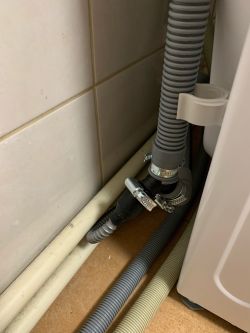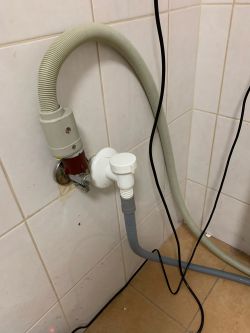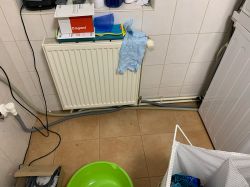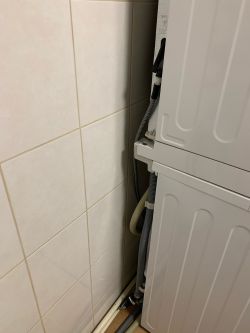FAQ
TL;DR: Rotate the inlet Aqua Stop 180°, and route both drain hoses to a wall standpipe; "Use the tee only at the drain pipe in the wall." This stops pump-back into the dryer and seals better on long runs. [Elektroda, Kenworth 18, post #19037489]
Why it matters: Prevents crossflow, odors, and potential dryer damage when sharing a distant drain—especially in stacked LG setups.
Quick Facts
- Distance reported: ~3 m to the drain; with a low tee, water rose into the dryer hose during pump-out. [Elektroda, misiek-puchatek, post #19035981]
- Placement: install the wye/tee at the wall standpipe, not mid-hose behind appliances. [Elektroda, Kenworth 18, post #19037489]
- Hose routing: form an inverted U on the washer hose per manual to deter siphoning. [Elektroda, Kenworth 18, post #19037489]
- Maintenance: check and clear the siphon/trap; lint or hair can clog and cause backflow. [Elektroda, stanislaw1954, post #19036528]
- Aqua Stop: orientation doesn’t affect function per an expert; horizontal still works. [Elektroda, zhudomel, post #19042469]
Can I connect an LG F4WV710P1 washer and RC90V9AV3Q dryer to one drain?
Yes—share a single drain by joining both hoses at the wall standpipe, not mid-hose. Install the tee at the wall inlet. Route the washer hose in an inverted U at the standpipe entry. This setup minimizes backflow and leaks during pump-out. [Elektroda, Kenworth 18, post #19037489]
Why does water back up into my dryer hose when the washer drains?
A low, mid-run tee lets the washer pump push water up the other branch. “Separate drain hoses from both devices would solve this problem.” Move the junction to the wall standpipe instead. That change stops forced flow into the dryer hose. [Elektroda, Kenworth 18, post #19037869]
Where should I place the tee or wye to share a drain?
At the wall drain/standpipe entrance. “You should use the tee only at the drain pipe in the wall.” Avoid tees behind the stack or on the floor. Keep both hoses independent until they reach the standpipe. [Elektroda, Kenworth 18, post #19037489]
Do I need to form an inverted U in the washer drain hose?
Yes. Shape the hose into a firm inverted U near the standpipe. This is the arrangement recommended in washing machine manuals. It helps deter siphoning and stabilizes the connection height. [Elektroda, Kenworth 18, post #19037489]
Should I rotate the inlet valve/Aqua Stop 180°?
One expert recommends rotating the angle valve so the mechanical Aqua Stop points vertically down. The goal is reliable leak actuation at the tap. If it currently points sideways, rotate it 180° for a vertical orientation. [Elektroda, Kenworth 18, post #19037489]
Will the mechanical Aqua Stop still work if mounted horizontally?
Yes. Another expert states orientation does not affect operation, so horizontal mounting still works. You can mount it discreetly behind the washer if space is tight. [Elektroda, zhudomel, post #19042469]
Could a clogged siphon be causing retraction or leaks?
Yes. Lint and hair can clog the trap and restrict flow. Inspect the siphon and clear any buildup. A slow or blocked trap increases pressure and encourages backflow through a shared tee. Clean it before changing the hose layout. [Elektroda, stanislaw1954, post #19036528]
What hose diameters should I use for a shared drain?
Match the common section to at least the washer hose diameter. Hoses from the washer and dryer may differ, so use compatible tees or adapters. Undersized junctions increase restriction, noise, and leak risk at clamps. [Elektroda, stanislaw1954, post #19036528]
Is backflow harmful to the dryer?
It can be. “...may have a negative impact on the dryer.” Prevent forced flow into the dryer hose by keeping drains separate until the wall standpipe. That avoids exposing the dryer’s condensate path to wastewater. [Elektroda, Kenworth 18, post #19037869]
How do I stop backflow when sharing one drain?
Use this quick fix:
- Move the junction to the wall: install a tee at the standpipe inlet.
- Route each appliance’s hose separately to the wall.
- Form an inverted U at the standpipe entry to set the proper height.
This arrangement prevents crossflow between hoses. [Elektroda, Kenworth 18, post #19037489]
My drain is 3 m away and I can’t move the stack. What’s the clean solution?
Extend the wall drain toward the appliances and terminate behind or beside the washer. Remove the existing siphon if needed and finish at standpipe height. Then connect both hoses at the new wall inlet with a proper tee. This avoids mid-run extensions. [Elektroda, zhudomel, post #19037964]
Does a 3 m drain run increase backflow risk with a low tee?
Longer runs increase hose volume. During pump-out, water can climb into a shared branch before reaching the trap. The original poster saw water rise toward the dryer with a 3 m drain and a low tee. Shift the junction to the wall to stop it. [Elektroda, misiek-puchatek, post #19035981]
My tee connection seeps. How can I fix it quickly?
Reseat the hoses fully on the fittings and tighten quality worm-drive clamps. Recheck that each hose meets the tee at the correct diameter. Re-clamping often stops minor seeping at the dryer branch connection. Avoid over-tightening to prevent hose damage. [Elektroda, misiek-puchatek, post #19036699]
Is it okay to remove the check ball in the siphon?
Don’t rely on internal ball removal to cure backflow. Rework the drain path instead. Remove the siphon, extend the wall drainage toward the washer, and finish at standpipe height. Then join both hoses at that wall inlet with a suitable tee. [Elektroda, zhudomel, post #19037964]
Do I need separate drains for washer and dryer, or can they share?
They can share one standpipe if you join them at the wall. Avoid a mid-run tee. As one expert noted, “separate drain hoses from both devices would solve this problem.” Route each hose independently to the wall junction. [Elektroda, Kenworth 18, post #19037869]










